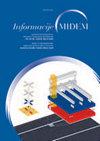A Computationally Efficient 11 Band Non-Uniform Filter Bank for Hearing Aids Targeting Moderately Sloping Sensorineural Hearing Loss
IF 0.8
4区 工程技术
Q4 ENGINEERING, ELECTRICAL & ELECTRONIC
Informacije Midem-Journal of Microelectronics Electronic Components and Materials
Pub Date : 2020-11-20
DOI:10.33180/infmidem2020.301
引用次数: 1
Abstract
A computationally efficient 11 band non-uniform filter bank addressing low or moderately sloping sensorineural hearing loss - the most common type of hearing problem- is proposed. This structure is suitable for low cost, small area implementations of hearing aids. The computational efficiency is achieved by adopting the Frequency Response Masking technique, which uses only two prototype filters with a total of 19 multipliers at 80dB stopband attenuation for the design of entire non-uniform filter bank. The computational complexity analysis shows that the proposed method provides about a 70-90% reduction in computational resources compared to non-FRM methods and about a 40-80% reduction in computational resources compared to the other FRM methods. The audiogram matching performance analysis shows that the matching error of the proposed filter bank is negligible even without optimization. The delay performance of the filter bank is acceptable for both Closed Canal Fittings and Open Canal Fittings.针对中度倾斜型感音神经性听力损失的助听器计算高效的11波段非均匀滤波器组
提出了一种计算效率高的11波段非均匀滤波器组,用于解决低倾斜或中等倾斜的感觉神经性听力损失-最常见的听力问题类型。这种结构适用于低成本、小面积的助听器实施。采用频率响应掩蔽技术,在80dB阻带衰减下,仅使用两个原型滤波器,共19个乘子来设计整个非均匀滤波器组,从而提高了计算效率。计算复杂度分析表明,该方法与非FRM方法相比,计算资源减少约70-90%,与其他FRM方法相比,计算资源减少约40-80%。听图匹配性能分析表明,即使不进行优化,所提滤波器组的匹配误差也可以忽略不计。滤波器组的延迟性能对于封闭管接头和开放管接头都是可以接受的。
本文章由计算机程序翻译,如有差异,请以英文原文为准。
求助全文
约1分钟内获得全文
求助全文
来源期刊
CiteScore
1.80
自引率
0.00%
发文量
10
审稿时长
>12 weeks
期刊介绍:
Informacije MIDEM publishes original research papers in the fields of microelectronics, electronic components and materials. Review papers are published upon invitation only. Scientific novelty and potential interest for a wider spectrum of readers is desired. Authors are encouraged to provide as much detail as possible for others to be able to replicate their results. Therefore, there is no page limit, provided that the text is concise and comprehensive, and any data that does not fit within a classical manuscript can be added as supplementary material.
Topics of interest include:
Microelectronics,
Semiconductor devices,
Nanotechnology,
Electronic circuits and devices,
Electronic sensors and actuators,
Microelectromechanical systems (MEMS),
Medical electronics,
Bioelectronics,
Power electronics,
Embedded system electronics,
System control electronics,
Signal processing,
Microwave and millimetre-wave techniques,
Wireless and optical communications,
Antenna technology,
Optoelectronics,
Photovoltaics,
Ceramic materials for electronic devices,
Thick and thin film materials for electronic devices.

 求助内容:
求助内容: 应助结果提醒方式:
应助结果提醒方式:


